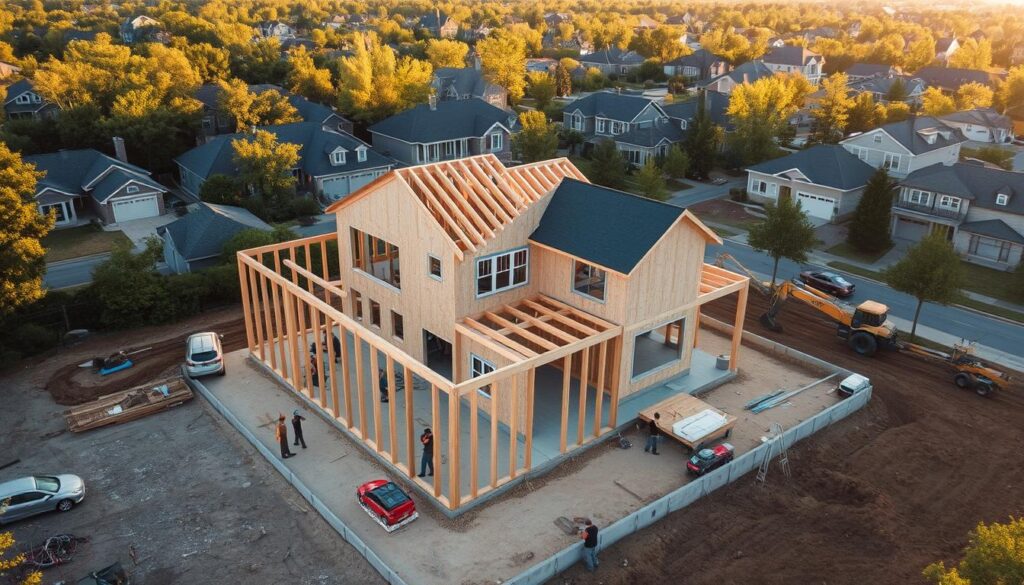Purchasing a freshly built house is an exciting milestone. However, the final inspection process requires careful attention to detail. This guide offers essential insights for buyers preparing to review their property before closing. With expertise from New Homes Houston Texas, located in Houston, TX, readers gain practical strategies to navigate this critical phase confidently.
A structured walk-through ensures every element meets quality standards. Professionals recommend focusing on both visible finishes and functional systems like plumbing or electrical work. Buyers should verify that all agreed-upon features align with the initial building plans and contract terms.
This article provides a step-by-step approach to identifying potential issues, from minor cosmetic flaws to structural concerns. Readers will learn how to document findings effectively and communicate repair requests clearly. The included checklist simplifies tracking priorities during inspections.
Whether it’s your first home or an investment property, understanding these evaluations helps protect your real estate investment. New Homes Houston Texas (954-821-4492) combines construction knowledge with local market experience, offering tailored advice for Houston-area buyers.
Key Takeaways
- Walk-throughs ensure quality control and contract compliance for newly built houses
- Professional checklists help systematically evaluate interior and exterior features
- Clear documentation streamlines communication with builders about repairs
- Local expertise matters – Houston-specific factors influence construction standards
- Thorough inspections prevent costly surprises after moving into the property
Introduction to New Construction Walkthroughs in Houston
A structured evaluation before closing ensures your property meets quality benchmarks. Builders often schedule these inspections during the construction phase, referring to them as “Blue-Tape Day” or “Initial Walk.” During this time, professionals and buyers collaborate to flag concerns using removable markers.
“A detailed checklist transforms this process from overwhelming to manageable,” notes a Houston-based builder. “It gives buyers confidence that every detail aligns with their expectations.”
Seasoned real estate experts emphasize three critical phases:
| Phase | Purpose | Key Focus |
|---|---|---|
| Initial Walk | Surface-level inspection | Paint, fixtures, flooring |
| Blue-Tape Day | Detailed defect marking | Cabinetry, appliances, trim |
| Final Review | Repair verification | Systems, safety features |
Guides from New Homes Houston Texas simplify this work by providing actionable checklists. These tools help verify everything from plumbing functionality to window seals. Buyers who prepare thoroughly reduce post-closing surprises.
Local construction standards and climate factors make Houston evaluations unique. Partnering with professionals familiar with regional building codes ensures comprehensive assessments. This approach safeguards your investment while maintaining project timelines.
Understanding the New Home Construction Process
The journey from an empty lot to a completed residence follows a structured timeline. Each phase demands precise coordination between builders, designers, and quality inspectors. Thorough evaluations at critical milestones ensure the property meets safety standards and design specifications.

Stages from Foundation to Final Build
Five key phases shape the building timeline. Foundation work establishes structural integrity, followed by framing that defines room layouts. Insulation and drywall installation create weatherproof interiors, while finish work adds aesthetic details. Final walkthroughs confirm all systems operate correctly.
| Phase | Primary Focus | Inspection Points |
|---|---|---|
| Foundation | Structural stability | Concrete curing, drainage |
| Framing | Layout accuracy | Wall alignment, openings |
| Mechanicals | System functionality | Electrical wiring, plumbing |
| Interior Finish | Aesthetic quality | Paint consistency, trim |
| Final Review | Code compliance | Safety features, appliances |
The Importance of Inspection and Review
Regular checks prevent minor issues from becoming costly repairs. Builders and real estate professionals collaborate to verify materials match design plans. Interior evaluations check finish quality, while exterior assessments confirm weather resistance.
Using a step-by-step guide helps buyers track progress effectively. This approach maintains transparency throughout the work timeline and protects the property’s long-term value. Knowledgeable oversight transforms complex processes into manageable tasks.
Pre-Walkthrough Preparation and Essential Tools
Proper planning is the cornerstone of a successful inspection, turning potential oversights into documented priorities. Buyers who invest time upfront often catch discrepancies early, saving money and stress later. This phase bridges expectations with reality, ensuring your vision matches the finished product.
Review Floor Plans and Blueprints
Studying architectural drawings reveals the property’s intended layout. Compare room dimensions, window placements, and structural elements against the physical space. This helps identify deviations like misplaced electrical outlets or undersized closets.
“Blueprints are the DNA of your home – they show what it should become,” explains a Texas-based contractor. “Spotting variances early keeps projects on track.”
Focus on elevations for exterior details and cross-sections for interior systems. Verify ceiling heights match specifications, especially in finished basements or bonus rooms.
Assemble Your Inspection Toolkit
A well-stocked kit transforms casual glances into professional-grade evaluations. Essential items include:
| Tool | Purpose | Pro Tip |
|---|---|---|
| Laser level | Check surface alignment | Test countertops & shelves |
| Thermal leak detector | Find insulation gaps | Scan exterior walls |
| Smartphone app | Document issues | Timestamp photos |
Flashlights expose shadowy corners, while measuring tapes confirm appliance clearances. Bring paint swatches to verify finish colors match selections. Cross-reference findings with warranty coverage to prioritize repair requests.
This preparation makes the walkthrough efficient and thorough. You’ll confidently verify every feature, from cabinet hardware to HVAC vents, knowing you’ve left nothing unchecked.
what happens at new construction walkthroughs houston
The final evaluation of a recently built property combines visual checks with technical assessments. Buyers systematically verify that all design elements and functional systems meet agreed standards. This phase ensures your dream house aligns with contractual promises before ownership transfers.
Key Evaluation Areas During the Inspection
Focus on these priority zones during your review:
| Category | Checkpoints | Tools Needed |
|---|---|---|
| Surface Quality | Paint consistency, flooring gaps, trim alignment | Flashlight, level |
| Functional Systems | Plumbing pressure, electrical outlets, HVAC airflow | Outlet tester, thermometer |
| Contract Compliance | Fixture brands, appliance models, material grades | Spec sheets, contract copy |
Hidden issues like improper sealing or insulation gaps often surface during detailed checks. Houston’s humidity makes moisture resistance particularly crucial in kitchens and bathrooms.
Benefits of Hiring a Third-Party Inspector
Independent professionals bring fresh eyes to the process. They identify oversights even experienced buyers might miss, especially with complex systems.
“Builders appreciate thorough inspections – they prevent post-closing disputes,” shares a Texas-certified home inspector. “We document issues objectively, making repair negotiations smoother.”
Third-party reviews strengthen warranty claims by creating timestamped records. They also verify that correction timelines meet local real estate regulations. This extra layer of scrutiny protects your investment long after moving in.
Comprehensive Exterior Inspection Guidelines
A property’s outer structure forms its first line of defense against the elements. Careful examination during this phase safeguards both aesthetics and functionality. Start by circling the entire perimeter, noting visible flaws and potential problem areas.
Foundation, Grading, and Roof Check
Look for hairline cracks in concrete slabs or uneven settling around piers. Use a level to confirm proper drainage slopes away from the home’s base. These steps help prevent water intrusion that could damage interior spaces over time.
| Checkpoint | Focus Areas | Tools |
|---|---|---|
| Roof | Missing shingles, rusted flashing | Binoculars, drone |
| Gutters | Secure attachments, debris clearance | Ladder, gloves |
| Siding | Color consistency, warped panels | Moisture meter |
Builders should address these common exterior concerns:
- Paint streaks or thin coverage on trim
- Misaligned downspouts directing water toward the foundation
- Gaps between window frames and exterior walls
“Exterior flaws often hint at deeper issues,” says a Texas-licensed inspector. “Peeling paint near gutters might indicate chronic moisture exposure needing immediate attention.”
Proper grading and gutter systems protect landscaping while preserving the home’s structural integrity. Real estate professionals recommend verifying these features meet local building codes. Thorough reviews during this phase help maintain curb appeal and prevent costly repairs after moving in.
Detailed Interior Evaluation Techniques
Your home’s interior quality directly impacts daily living experiences. Focused inspections during this phase ensure every surface and system meets your builder’s promises. This process transforms a house into a polished living space ready for memories.
Doors, Windows, and Finish Quality
Test every door and window for smooth operation. Look for sticking hinges, uneven gaps, or drafts around frames. Built-in cabinets should open quietly and align perfectly with surrounding trim.
| Element | Checkpoints | Common Issues |
|---|---|---|
| Doors | Latch alignment, weather stripping | Scratched surfaces |
| Windows | Lock function, glass clarity | Condensation between panes |
| Trim Work | Mitered corners, nail holes | Uneven caulking |
“Finish details separate good construction from great craftsmanship,” says a Texas home designer. “Consistent paint sheen across walls and trim shows builder pride.”
Wall, Ceiling, and Floor Standards
Use angled lighting to reveal imperfections in drywall seams. Check for:
- Visible tape lines under paint
- Flooring gaps near baseboards
- Ceiling texture consistency
Walk barefoot across floors to detect uneven areas. Verify tile grout color matches samples and contains no cracks. These steps help create the dream home environment buyers envision while preventing future maintenance headaches.
Document every finding with photos and notes. This record becomes crucial if warranty claims arise later. Thorough reviews ensure your living spaces meet both aesthetic and functional expectations from day one.
Systems and Safety Assessments
A home’s hidden systems form its operational backbone. Thorough evaluations before closing verify safety and efficiency across electrical, plumbing, and climate control components. These checks protect your investment while ensuring daily comfort.
Electrical and Plumbing Systems Review
Licensed inspectors test every outlet and circuit for proper grounding. They measure water pressure and check for leaks behind walls. Common focus areas include:
| System | Checkpoints | Red Flags |
|---|---|---|
| Electrical | GFCI functionality, panel labeling | Flickering lights |
| Plumbing | Drain speed, shut-off valves | Discolored water |
“We simulate real-world use by running multiple fixtures simultaneously,” shares a certified home inspector. “This reveals hidden capacity issues builders might overlook.”
HVAC, Insulation, and Energy Efficiency
Proper insulation reduces energy bills while maintaining consistent temperatures. Inspectors measure airflow from vents and check ductwork seals. Attic assessments verify adequate insulation depth and vapor barriers.
Key efficiency indicators include:
- SEER ratings matching contract specifications
- Consistent temperatures across rooms
- No drafts around windows or doors
These evaluations help buyers confirm their real estate purchase meets modern efficiency standards. Addressing minor issues early prevents major repairs after moving in, preserving the home’s long-term value.
Final Walkthrough and Punch-Out Process

The last inspection before ownership transfer acts as a critical quality gate. Buyers systematically verify that all agreed-upon repairs and installations meet contractual obligations. This phase bridges construction completion with move-in readiness, ensuring no detail escapes scrutiny.
Identifying Last-Minute Repairs and Issues
Builders and buyers collaborate during this final review to address lingering concerns. Focus shifts to verifying completed corrections and catching overlooked items. Common punch list tasks include:
| Category | Typical Items | Verification Method |
|---|---|---|
| Fixtures | Loose handles, scratched surfaces | Physical inspection |
| Systems | HVAC calibration, circuit testing | Operational checks |
| Finishes | Paint touch-ups, grout consistency | Visual assessment |
“The punch-out phase turns a house into a home,” remarks a Texas builder. “We prioritize repairs that affect livability, ensuring families settle into flawless spaces.”
Detailed checklists prove invaluable during this stage. They help track completed tasks and pending actions systematically. Buyers should test every light switch, faucet, and appliance while documenting inconsistencies.
Effective communication streamlines resolution timelines. Builders typically allocate dedicated crews to address final repairs within days. Immediate documentation of issues prevents post-closing disputes and maintains real estate transaction momentum.
Additional Considerations and Warranty Information
Finalizing your property purchase involves more than approving walls and windows. Attention to post-construction details ensures lasting satisfaction with your investment. This phase focuses on confirming operational readiness and understanding long-term protection plans.
Evaluating Fixtures, Appliances, and Landscaping
Test every installed feature thoroughly before closing. Run dishwashers through full cycles, check oven temperatures, and inspect faucet connections. Outdoor spaces require equal scrutiny:
| Area | Checkpoints | Warranty Impact |
|---|---|---|
| Appliances | Manufacturer stickers, error codes | Registration deadlines |
| Light Fixtures | Switch functionality, bulb types | Electrical code compliance |
| Landscaping | Irrigation coverage, plant health | Grading warranties |
“Warranties aren’t just paperwork – they’re your safety net for unexpected issues,” advises a Texas home service manager. “Understand coverage timelines before signing final documents.”
Discuss maintenance schedules with your builder. Clarify responsibilities for gutter cleaning, HVAC servicing, and exterior treatments. Many contracts include 1-2-10 warranties covering:
- 1 year for workmanship defects
- 2 years for mechanical systems
- 10 years for structural components
Keep repair negotiation records and finalize adjustments through escrow if needed. A detailed checklist tracking interior finishes, exterior features, and service plans simplifies future reference. This proactive approach turns contractual protections into practical peace of mind.
Ensure a Successful New Home Walkthrough: Key Takeaways
A meticulous final review transforms house keys into lasting peace of mind. Thorough evaluations protect your investment by verifying every detail matches agreed standards – from foundation integrity to appliance functionality. This process ensures your living space meets both aesthetic expectations and practical needs.
Key inspection items include exterior weatherproofing, interior finish quality, and system performance checks. Independent inspectors add valuable expertise, often spotting issues even vigilant buyers might miss. Their reports strengthen warranty claims and clarify repair priorities with builders.
Regular maintenance starts with understanding your home’s unique features during this critical phase. Keep records of all service agreements and warranty timelines for future reference. These steps help preserve property value while minimizing unexpected costs.
New Homes Houston Texas offers tailored guidance through every evaluation stage. Their team combines local market knowledge with construction expertise to simplify complex processes. For personalized support or questions about your review checklist, call 954-821-4492 today.
Turn inspection insights into confident homeownership. Your dream living space deserves nothing less than professional-grade scrutiny before you settle in.





